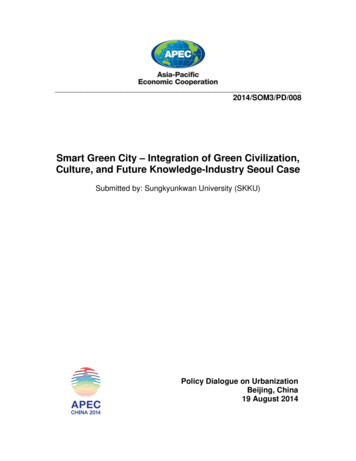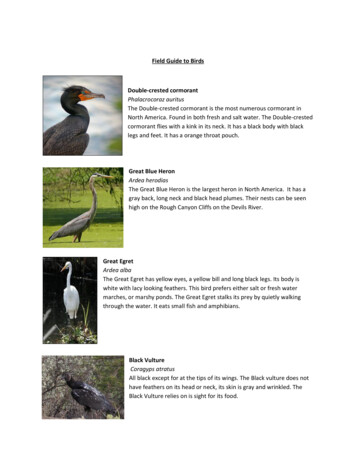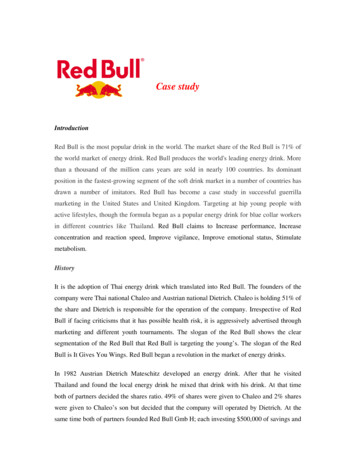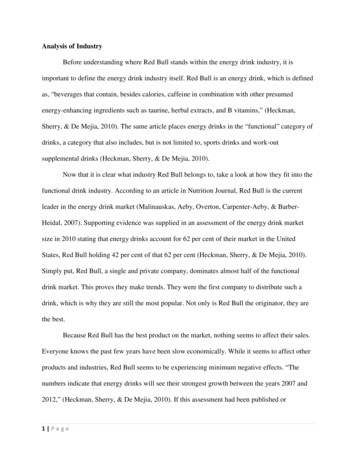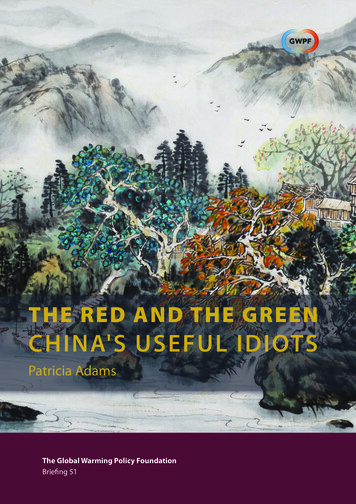
Transcription
THE RED AND THE GREENCHINA'S USEFUL IDIOTSPatricia AdamsThe Global Warming Policy FoundationBriefing 51
The Red and the Green: China's Useful IdiotsPatricia AdamsBriefing 51, The Global Warming Policy Foundation Copyright 2020, The Global Warming Policy Foundation
ContentsAbout the author iiiIntroduction 1The Greens and the Reds 1The Reds and the Green 5Conclusion 9Notes 10About the Global Warming Policy Foundation 14About the authorPatricia Adams is an economist and the executive director of Probe International, a Toronto-basedNGO that has been involved in the Chinese environmental movement since its beginnings in themid-1980s through the publication of books such as Damming the Three Gorges and Three GorgesProbe, a news portal published in English and Chinese. As editor of the English language translation of Yangtze! Yangtze!, the book that helped inspire China’s democracy movement, and as anauthor and contributor to books and journals on China’s environmental crises, she is an authorityon China’s environmental policy. Ms Adams, a founder of the World Rainforest Movement and theInternational Rivers Network, has testified before Congressional and Parliamentary Committees inthe US and Canada, and has often appeared in major media, including the BBC, CBC, NPR, New YorkTimes, Wall Street Journal, the Globe and Mail and National Post.
iv
IntroductionFor those who were under the illusion that China’s Communist regime is aforce for good in the world, the last few years have been a wakeup call. Under President Xi, China incarcerated over a million Turkic Uighur Muslims in‘re-education’ camps, unleashed the coronavirus pandemic on the world,violated its treaty with Britain by ending Hong Kong’s self-rule, exacerbated its territorial disputes with virtually all its neighbours and has vowed toinvade Taiwan.Through these eye-opening actions, among others, public opinionthroughout the West has changed dramatically. Whereas the majority previously saw China favourably – as a benign giant – nowadays only 15%of Australians, 14% of Swedes, 22% of British, 23% of Canadians, 25% ofGermans, and 22% of Americans still feel the same way, according to a Pewsurvey published in October.1 Most now recognize that the Chinese Communist Party (CCP) lies, cheats, steals, threatens, and kidnaps in order toget its way in business and diplomatic relations, and that the regime is hostile to rules-based institutions. As catalogued by the Center for Strategicand International Studies’ Bonnie Glaser, Western countries cannot assumeChinese goodwill:Canada is among the countries, of course, that have been targeted forharming Chinese interests and offending Chinese sensibilities. The arrestof Canadian citizens and the ban on imports of Canadian canola oil andother agricultural products are just the latest examples of Chinese economic coercion aimed at punishing countries that harm Chinese interests.The list of target countries is long: Norway, for granting the Nobel PeacePrize to Chinese dissident Liu Xiaobo; Japan, for arresting a Chinese shipcaptain after he rammed a Japanese Coast Guard vessel in disputed waters; the Philippines, for confronting Chinese fishermen operating in Scarborough Shoal; and on and on, as well as South Korea for THAAD [Terminal High Altitude Area Defense], etc.2The Greens and the RedsThe big exceptions – those who have yet to have their eyes opened tothe dangers posed by the CCP – are Western environmentalists and theirfunders. Rather than becoming cautious about China’s role in the world,these groups lavish it with praise for its environmental efforts, using superlatives such as ‘herculean‘3 and ‘momentous.’4 Greenpeace announced that‘Prioritising sustainability will cement China’s legacy as it assumes a largerrole on the global stage.'5 WWF said that ‘The new aspiration announced byPresident Xi reflected China’s unswerving support and decisive steps to enhance climate ambition.'6 The Natural Resources Defense Council’s BarbaraFinamore even wrote a laudatory book entitled Will China Save the Planet?7The environmental gushing for China is reciprocated by the regime,with CCP media organs such as China Daily and Xinhua dedicating fullpage articles to celebrating the environmental movement's partnership.8Western environmental organisations, in fact, enjoy a privileged posi1
tion in China. Following a 2017 law governing foreign NGOs,9 most foreignadvocacy organisations – from human rights groups such as Amnesty International and Human Rights Watch to legal aid groups such as ChineseUrgent Action Working Group – were either extremely restricted or effectively banned. Prior to the NGO law, some 7000 foreign organisations operated in China.10 Today that number is 553, 50% of them trade associationsand business lobbies and most of the balance split between health, education, relief, and science and technology; apolitical organisations whosework is not advocacy in nature.11 Fewer than 4% of the 553 organizationsthat remain are what a Westerner would consider an environmental group,and all do Beijing’s bidding.As with other foreign organisations still permitted to operate in thecountry, green groups must be formally sponsored by a designated stateagency or government department. However, despite the name, the sponsor is not passive, but instead is responsible for monitoring and supervisingthe environmental groups’ work, sometimes even working hand-in-glovewith them on joint projects. Supervision also includes ‘regulatory talks’ andinspections of premises. Foreign NGOs are required to submit annual plansfor projects and use of funds to their sponsor for approval.Foreign organisations must also agree to close supervision by the Ministry of Public Security.12 Failure to comply with the provisions of the NGOlaw13 can result in seizure of assets, detention of staff, and a ban on futureefforts to work in the country for five years, all without any recourse to appeal.14 Offences include activities that may ‘jeopardise the national unity,security, and ethnic harmony of China,’ ‘harm the national interest, socialpublic interest, or the lawful rights and interests of citizens, legal persons,and other organisations of China,’ or that risk ‘splitting the state, damaging national unity, or subverting state power.’15 Foreigners found to havebreached the law can either be barred from leaving China or deported.162
As one example of the exercise of this law, a Chinese foreign ministry spokesman suggested that former Canadian diplomat Michael Kovrig,with the International Crisis Group think tank, may have violated the NGOlaw because his employer was not legally registered in China,17 althoughthat charge was later dropped. However, according to the country's normalpractice that ‘the law is whatever the CCP wants it to be,’ Kovrig was eventually charged with ‘spying on national secrets’18 and providing intelligencefor ‘outside entities.’19 Arrested in 2018,20 he remains today in solitary confinement without regular consular visits and in conditions that Canada’sGlobe and Mail calls ‘torture.’21The embrace by environmental groups and their funders of the CCPis understandable. Their desire to rid the world of fossil fuels depends entirely on China, which accounts for more than 75% of the world’s net globalenergy growth.22 Without the country coming on board, carbon-curbingefforts elsewhere would be futile, dashing the environmentalists’ dream.Imagine their delight, and relief, to see Beijing mouth everything the environmentalists espouse.The vast sums provided to the climate change cause provides an added incentive, nowhere more so than in China. Lavishly funded – one USbased charitable group, San Francisco-based Energy Foundation China, hasprovided over US 330 million to US registered organisations operating inChina – they are able to spare no expense in pursuing their efforts to ridthe planet of fossil fuels. 23 In turn, funding for Energy Foundation Chinacomes courtesy of other Western foundations such as William and FloraHewlett Foundation, The David and Lucile Packard Foundation, the John D.and Catherine T. MacArthur Foundation.24 The MacArthur Foundation’s listof other China grants includes 10 million each to Environmental DefenseFund and Nature Conservancy.25Apart from the power and prestige environmental activists enjoy inthis role, many doubtless welcome the opportunity to use their researchto promote their progressive goals. Given the perceived urgency of theircause – saving the very planet – they can easily justify turning a blind eyeto China’s aggression in the South China Sea or human rights abuses on themainland.China’s embrace of Western environmentalists is also understandable.To borrow a line attributed to Lenin, these environmentalists are the CCP’s‘useful idiots’. The Communist government not only monitorstheir activities in China to ensure their compliance with government policy, it also exercises the ability to direct the agendathat the environmentalists willcarry out via the Communistgovernment’s de factocontrol over the useof funds.3
The CEO and President of Energy Foundation China, for example, is JiZou, a Chinese national with a long career as a senior official in China’s communist government. As noted on the organisation’s website, Zou previously served as a deputy director-general of China’s National Center for ClimateChange Strategy and International Cooperation, under the government’sNational Development and Reform Commission, the Chinese government’ssuper-planning agency. Between 2000 and 2009, and between 2012 and2015, Zou was a prominent member of the Chinese climate negotiationteam leading up to the Paris Agreement, and between 2013 and 2014, heserved as a China representative to the United Nations IntergovernmentalCommittee of Experts on Sustainable Development Financing.26Zou, as a paymaster for the Western environmentalists, decides whatprojects to fund, enabling him to effectively solicit work desired by his former employers in Beijing from the Western environmental organizations,who give it their imprimatur of legitimacy. Moreover, the Chinese government doesn’t even need to fund this work.While critics of the CCP's many malign activities give it a black eye, theenvironmentalists’ glowing reports of China’s environmental leadershippaints the country in a favourable light and acts to put Beijing's critics onthe defensive. Environmentalists, in fact, have become the highest profilecheerleaders for the communists, helping to divert attention from the regime’s worrisome pursuits. Chief among these is China’s appropriation offossil fuel resources in the South China Sea and elsewhere in pursuit of itsgoal of displacing the United States as the dominant global economic andnational security superpower by 2050.274
The Reds and the GreenEnvironmentalists’ claims that China is committed to becoming carbon neutral by 2060, ten years after it has become the world’s dominant economy,is pure fantasy. China today relies on fossil fuels for 86% of its total primaryenergy consumption (58% from coal, 20% from petroleum and other liquids, and 8% from natural gas).28 Rather than curbing its appetite for fossilfuels, Beijing is voraciously seeking more.In the case of coal, China has aggressively relaxed regulations that restricted domestic coal production, seeking to rapidly raise production capacity. ‘In the first half of 2020 China approved 23 gigawatts-worth of newcoal power projects, more than the previous two years combined,’ reportedAFP, citing Global Energy Monitor, a San Francisco-based environmentalNGO.29 The CCP approved 141 million tons of new annual coal mining capacity in the first half of 2019. In all of 2018, it approved 25 million tons.30Moreover, aiming to turn itself into a major petrochemical producerand exporter, China is investing heavily in next-generation coal facilities,such as its 35 coal-to-chemicals projects, at a projected cost of 90 billion.31Coal-to-chemicals production is more carbon-intensive than conventionalpetrochemical production, indicating a willingness to increase carbon dioxide emissions over a long operating life. China’s coal-to-liquids programalso indicates its long-term intentions. At the end of 2016, Shenhua Groupbrought online the world’s largest coal-to-liquids plant, and it intends totriple its capacity by 2023. Likewise, China is encouraging the use of methanol, which is produced from its coal.32In 2018, more than 80% of the new energy fund launched by the Chinese Ministry of Industry and Information Technology went to subsidisingfracking and coalbed methane.33 The country’s pursuit of coal includes expansion of long-range railway capacity, such as the Haoji Railway, commis-5
sioned in October 2019, aiming to connect the country’s coal-producingcentres in the interior to its energy-hungry coasts.34President Xi may claim to be going off fossil fuels, but China is pursuing coal at a breakneck pace, with hundreds more coal-fired plants in theplanning phase. In fact, says OilPrice.com, ‘China has already added 11.4 gigawatts of coal power capacity just in the first half of 2020, which accountsfor more than half of the coal capacity added in the entire world in thesame six months.’35 Despite the climate-friendly rhetoric, reports Quartz, ‘inthe short term, China is still moving full steam ahead on coal – its post-Covid stimulus spending on fossil fuels is three times larger than its spendingon clean energy, including nearly 25 billion on coal power plants and evenmore on mining and processing.’36In oil, China has an ambitious program to build refineries. The new capacity that began coming online in 2019 includes the Hengli refinery in Liaoning and Zhejiang’s Rongsheng facility, both of which will have capacityto produce 400,000 barrels per day (b/d). Sinopec and Kuwait Petroleum’s200,000 b/d integrated refinery in Zhanjiang, a second phase of Zhejiang’sRongsheng plant, and the 320,000 b/d Shenghong Petrochemical refineryare slated to be online by the mid-2020s, while several other large refineriesare in the planning stage.37Because those are not enough, China plans to attract more investmentand technical expertise in its conventional upstream sectors by easing restrictions on foreign and private investment. ‘Previously, foreign firms couldnot own a majority stake in a project and were required to be part of a jointventure with one of the National Oil Companies to develop China’s oil andnatural gas fields,’ said the US Energy Information Administration (EIA).38Even before that loosening of restrictions, China’s installed crude oil refining capacity had reached about 17 million b/d, ranking it second behindthe US for capacity in 2019.39The increased capacity is needed to satisfy China’s ever-expanding oilconsumption. Last year, ‘China consumed an estimated 14.5 million b/d ofpetroleum and other liquids, up 500,000 b/d, or nearly 4%, from 2018,’ according to the EIA.40 This growth in oil consumption growth accounted foran estimated two-thirds of incremental global oil consumption.41 China hasbecome the world’s largest crude oil buyer, and its oil imports reached record highs in 2019.42 To ensure continued supply well into the future, China has diversified its sources of crude oil imports, entered into long-termcontracts with Saudi Arabia, its largest supplier, and increased its crudeoil imports from Russia, its second largest, through new construction ofpipeline and transmission infrastructure between thecountries.436
As with coal and oil, China is aggressively embracing natural gas. Overthe past decade, the country's natural gas demand increased by about 13%per year, making it the world’s third-largest consumer behind the US andRussia, and one of the fastest-growing natural gas markets in the world.44To meet that demand, domestic natural gas production has beensteadily rising, and the country's 13th Five Year Plan emphasises continuedgrowth. In its determination to promote domestic upstream developmentof unconventional deposits, China reduced the resource tax on shale gasproduction, extended subsidies on all unconventional production and, forthe first time, made tight gas (low-permeability natural gas found in reservoir rocks) eligible for subsidies.45 Projects range from the South China Sea,where CNOOC, China’s major offshore producer, plans to commission thecountry’s second deepwater natural gas field, Lingshui 17-2, to the newlyexplored large Bozhong 19-4 natural gas and condensate field in Bohai Bayin northeastern China.46Because those domestic measures will be unable to sate China’s immense appetite for natural gas, China’s natural gas production has beensteadily rising over recent years, and the country has become the largestnatural gas importer in the world. To enable those imports, China has invested heavily in infrastructure. As of 2019, it had 21 LNG regasification terminals and is quickly building terminals along its entire coastline.47Natural gas is also imported overland, by pipelines from Central Asiaand Burma, and increasingly from Russia through the Power of Siberiapipeline, which opened in December 2019. Through a 30-year natural gasdeal signed in 2014, China will import an average of 1.3 Tcf per year fromGazprom’s East Siberian fields.48China’s domestic pipeline infrastructure is also being transformed inline with the government’s goals. Last year, PipeChina was launched, allowing open access to the national pipeline.49 In addition, says the EIA, ‘in 2019,China began to allow foreign companies to invest in city natural gas distribution pipelines to facilitate greater investment levels and faster infrastructure development.’50 The notion that China’s Communist regime intends tobecome carbon neutral in 2060, when it is positioning its 25-trillion economy to run on fossil fuels in the future, as it does today, is ludicrous.7
8
ConclusionAs virtually all students of China now appreciate, the West wasfoolish to trust Communist China to change and embrace democracy once it had access to Western markets and Western values.Glacier News, reporting an interview with Garnett Genuis, ViceChair of the Special Committee on Canada-China Relations of theCanadian House of Commons, reported his view that China wasincapable of reform:A government that is genocidal and totalitarian is one that cannot be trusted. And I think it’s becoming harder and harder toargue the contrary, in this current environment. Today, there’sjust no excuse for having your head that far in the sand and yet,you know, we still have too many politicians that do.51Following the West’s misassessment of China, according toPaul Evans, Professor at the School of Public Policy and Global Affairs of the University of British Columbia, China has only becomemore of a bad actor. ‘Under Xi Jinping, China is more repressivedomestically and along its periphery than at any time since MaoZedong.’52As put by Bonnie Glaser, the foolishness of thinking Chinawould share Western values can be seen in almost every aspect ofits conduct:China does not respect rule of law. lt does not share liberal democratic values, and it does not protect human rights. It is seekingto alter the international system in ways that would be favourable to China and detrimental to western interests. China’s tool ofdomestic governance, its detention of over one million Uighurs,its censorship of expression, and its social credit system shouldnot be a model for the rest of the world.53For most, China is not a model for the rest of the world. For western environmentalists, sadly, all too often it is.9
Notes1. ‘Unfavorable Views of China Reach Historic Highs in Many Countries. Majorities say China hashandled COVID-19 outbreak poorly’ by Laura Silver, Kat Devlin and Christine Huang, 6 October2020, Pew Research Center, Global Attitudes & Trends at y-countries/.2. Special Committee on Canada-China Relations, Number 008, 1st Session, 43rd Parliament,Evidence, Monday, 9 March 2020 at ACN/meeting-8/evidence. According to The Chinese Communist Party’s Coercive Diplomacy byFergus Hanson, Emilia Currey, and Tracy Beattie, Australian Strategic Policy Institute, 1 September2020 (available at artys-coercive-diplomacy)27 countries plus the EU have been on the receiving end of China’s 152 cases of coercive diplomatictactics in the past 10 years and there has been a sharp escalation since 2018.3. According to ‘Emission Impossible: Can China go net-zero? Two charts show just how ambitiousXi Jinping’s goal is’, by Emily Pontecorvo in Grist, 2 October 2020 at s/: ‘Varun Sivaram,a senior research scholar at Columbia’s Center on Global Energy Policy, said he cannot begin toexpress how gargantuan a transformation it would be “It would be the most herculean thingever accomplished in human history”, he told Grist completely earnestly. “If the United States wereto go to net-zero by 2050, it would be great, but it would be far less impressive than China goingnet-zero by 2060”.’4. ‘ China’s new climate pledge could cut emissions everywhere else too ‘ , by Jocelyn Timperley in Wired, 12 October 2020 at -net-zero-carbonpledge. See also ‘China’s new carbon neutrality pledge: What next?’ in C hina Dialogue, 23 September2020 at rbon-neutrality-pledge-what-next/.5. ‘China’s Xi promises green ‘belt and road’ investment strategy’ by Megan Darby, 15 May 2017,Climate Home News at 6. ‘China’s game-changing pledge could boost global momentum on climate action’ by WWF,23 September 2020 at https://wwf.panda.org/wwf news/?876366/China-climate-NDC.7. Will China Save the Planet? by Barbara Finamore, Wiley, 28 November 2018 at -china-save-planet.8. ‘Teamwork urged on climate efforts’ by Liu Yinmeng, Los Angeles, China Daily, 26 October2020 at 2a4da31024ad0ba80dd0.html. Seealso, ‘China’s commitment to fighting climate change strong, important: WWF Int’l official’, Xinhua,1 October 2020 at http://www.xinhuanet.com/english/2020-10/01/c 139412144.htm. Also,‘Interview: China’s commitment to fighting climate change strong, important – WWF Internationalofficial’ by Martina Fuchs, Xinhua, 29 September, 2020 at http://www.xinhuanet.com/english/202009/29/c 139406459.htm. ‘Opportunity to be seized’ by Dimitri de Boer and Wang Yi, China Daily, 11August 2020, at 1e155a31083481725f6ee.html.9. Law of the People’s Republic of China on Administration of Activities of OverseasNongovernmental Organizations in the Mainland of China.10. ‘More than 7,000 foreign NGOs in China: Only 91 registered so far‘ by D.D. Wu, The Diplomat,2 June 2017, at eign-ngos-in-china-only72-registered-so-far/.10
11. ‘Registered foreign NGO representative offices interactive map and filterable table’ by TheChina NGO Project, as of 1 December 2020, at o-offices-map-full-screen/12. ‘China’s new NGO law: Navigating the restrictions and application procedures’ by DezanShira & Associates, 12 May 2016 at /.13. ‘Law of the People’s Republic of China on Administration of Activities of OverseasNongovernmental Organizations in the Mainland of China’ by The National People’s CongressStanding Committee, Adopted 28 April 2016, Effective 1 January 2017 at tivities-ofoverseas.14. Parkin, op. cit.15. ‘China: Law passed tightening control over foreign non-government organizations’ US Libraryof Congress, 15 June 2016 at ernment-organizations/.16. Human Rights Watch, op. cit.17. ‘Foreign NGO employee detained in Beijing: Ministry of Foreign Affairs suggests Michael Kovrigof International Crisis Group detained under foreign NGO law’ by Jessica Batke, 12 December 2018,The China NGO Project ChinaFile at mployeedetained-beijing18. ‘China charges Canadians Michael Kovrig and Michael Spavor with espionage’ by NathanVanderklippe, The Globe and Mail, 19 June 2020 at pying/19. ‘Michael Kovrig and Michael Spavor: China charges Canadians with spying’ by BBC, 19 June2020 at .20. Batke, op. cit.‘First U.S. NGO accused of breaking the overseas NGO law’ by Siodhbhra Parkin, 25 November 2019SupChina at sed-of-breaking-the-overseasngo-law/.In a separate, but clearly linked arrest, Michael Spavor, a Canadian entrepreneur working in Chinawas also arrested on the same day as Michael Kovrig, both in obvious retaliation for Canada’s arrestof Huawei’s CFO, Meng Wanzhou, daughter of Huawei founder and ‘Red Princess‘, on an extraditionrequest from the US for bank fraud. The ‘Two Michaels’ remain in jail while Ms. Meng lives underhouse arrest in her two mansions in Vancouver and receives the due process of law that she isentitled to in Canada as she challenges her extradition.21. ‘The continued imprisonment of the two Michaels is an act of pointless cruelty’ by The EditorialBoard, Globe and Mail, 30 July 2020 at haels-is-an-act-of-pointless/22. ‘Statistical Review of World Energy 2020,’ BP at omics/statistical-review-of-world-energy.html23. Energy Foundation China, Introduction, at https://www.efchina.org/About-Us-en/Introductionen and Grant Application at ion-en24. Energy Foundation China, Key Funders at https://www.efchina.org/About-Us-en/Funders-en25. MacArthur Foundation at https://www.macfound.org/about/ and https://www.macfound.org/grants/11
26. Energy Foundation China, Staff at -en27. 'China is the greatest, growing threat to America' by Jim VandeHei, 21 May 2018, Axios b63c-e86477e9cfe6.html.28. ‘China energy profile: Energy demand expected to increase – analysis’ by EIA (US EnergyInformation Administration), Eurasia Review, News & Analysis, 1 October 2020 at is/.29. ‘Two-headed beast’: China’s coal addiction erodes climate goals’ by AFP, 27 September 2020 hina-coal-addiction.html.30. ‘China coal mine approvals surge despite climate pledges’ by David Stanway, Muyu Xu, 6 August2019, Reuters at ate-idUSKCN1UW0EM.31. ‘Analysis: China’s Covid stimulus plans for fossil fuels three times larger than low-carbon’ byLauri Myllyvirta and Yedan Li in Carbon Brief, 23 September 2020 at -than-low-carbon. China'scoal-to-liquids projects are a subset of its coal-to-chemicals projects, which include synthetic liquid,gaseous fuels, plastics, and fertilisers. The Chinese government is making major investments incoal-to-chemicals projects for economic and security reasons - to use its abundant coal reserves torelieve the country's dependence on oil and gas imports. These carbon-intensive projects increasethe emissions intensity of fossil fuel consumption. They also lock in fossil fuel infrastructure wellbeyond the middle of the century.32. EIA, op. cit. See also: ‘Significant coal-to-liquid project in production in Ningxia' by Xinhua, ChinaDaily, December 28, 2016 at tent 27805385.htm33. ‘Why China’s renewable energy transition is losing momentum’ by Michael Standaert,26 September 2019, Yale Environment 360 at eenergy-transition-is-losing-momentum.34. EIA, op. cit.35. ‘Why China can’t quit its coal addiction’ by Haley Zaremba, Oil Price, 3 October 2020 at OilPrice.com at it-Its-Coal-Addiction.html.36. ‘One major obstacle to China’s new climate goals: its thousands of new coal plants: China isbuilding hundreds of new coal-fired power plants in spite of its new climate goals’ by Tim McDonnell,Quartz, 24 September 2020 at s-are-such-abig-climate-obstacle/.37. EIA, op. cit.38. Ibid.39. Ibid.40. Ibid.41. Ibid.42. ‘China’s crude oil imports surpassed 10 million barrels per day in 2019’ by EIA (US EnergyInformation Administration), 23 March 2020, at https://www.eia.gov/todayinenergy/detail.php?id 43216#: :text l%20imports%20in%202019.‘China’s oil imports are falling from record highs’ by Tsvetana Paraskova at OilPrice.com, 4 November2020 at Oil-Imports-Are-Falling-From-Record12
Highs.html#: :text Having%20hit%20an%20all%2Dt
‘useful idiots’. The Communist government not only monitors their activities in China to ensure their compli-ance with government policy, it also exer-cises the ability to direct the agenda that the environment


